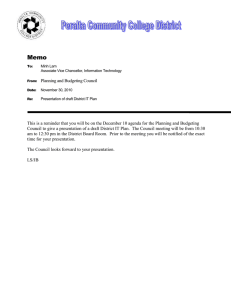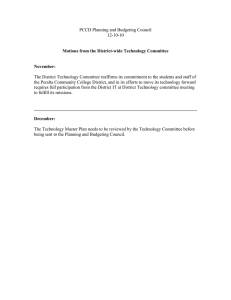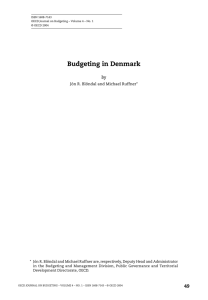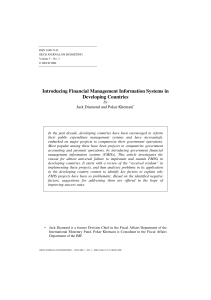INTERNATIONAL EXPERIENCES IN USING PERFORMANCE
advertisement
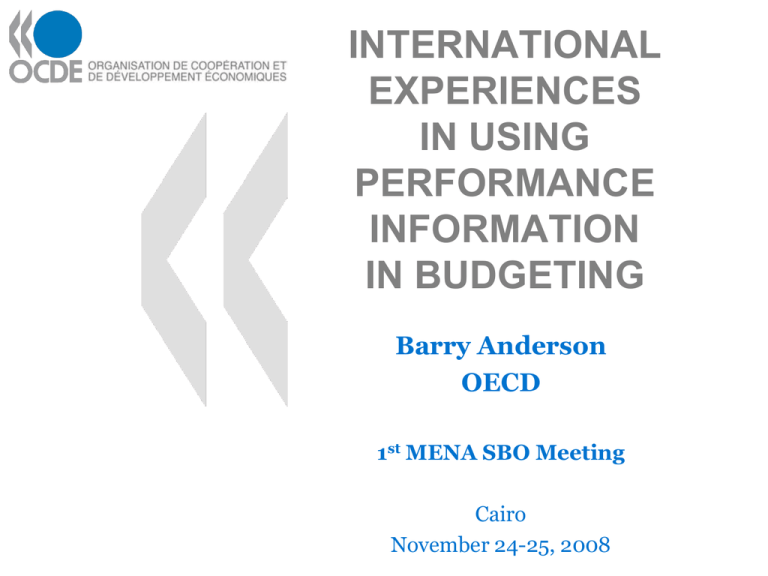
INTERNATIONAL EXPERIENCES IN USING PERFORMANCE INFORMATION IN BUDGETING Barry Anderson OECD 1st MENA SBO Meeting Cairo November 24-25, 2008 Perhaps The Most Important Trend In Government Budgeting Is The Shift To Performance Budgeting • Away from “Budgeting for Inputs” – “How much money can I get?” • Towards “Budgeting for Measurable Results” – “What can I achieve with this money?” See: Performance Budgeting in OECD Countries, OECD, September, 2007. 2 Performance Information (PI) Improves The Quality of Government Decision-Making It generates a sharper focus on results within the government. It provides more & better information on government goals & priorities, & on how different programmes contribute to achieve these goals. It encourages a greater emphasis on planning & acts as a signaling device that provides key actors with details on what is working & what is not. It improves transparency by providing more & better information to Parliaments & to the public. It has the potential to improve the management of programmes & efficiency. 3 OECD Guidelines for the Use of PI 1. 2. 3. 4. There is no one model of performance budgeting. A whole-of-government planning & reporting framework is important. PI should be integrated into the budget process. Designing government-wide systems that automatically link performance results to resource allocation should be avoided, because such systems may distort incentives. 5. Meaningful & accountable PI requires reliable output & outcome data that are continuously updated. 6. Timely & straightforward assessments of performance information should be carried out independently of the spending ministries & be supported by external expertise. 7. The support of political & administrative leaders is vital for implementation. 8. The staff & resource capacity of the ministry of finance & spending ministries is critical. 9. Reform approaches need to be adapted to evolving circumstances. 10. It is important to develop incentives to motivate civil servants and politicians to change their behavior. 4 However, Few Countries Have Successfully Integrated PI Into Their Budget Processes • Issues remain on: – how to improve the use of PI in budgetary decision making; – how & if PI should be related to resources; – how to improve the measurement of activities; – how to improve the quality of information; – how to get politicians to use PI in decision making. 5 OECD Guidelines for the Implementation of PI • Find an implementation approach appropriate to wider governance & institutional context. • Allow flexibility in implementation. • Get the support of political and administrative leaders. • Develop the capacity of the finance ministry and spending ministries. • Focus on outcomes, not just outputs. • Have precise goals, and measure and monitor progress towards achieving them. • Ensure good knowledge of the programme base. • Limit the number of targets, but use many measures. • Have information systems that communicate with each other. • Promote cross-organizational co-operation. • Emphasize consultation and ownership. • Consider how changes to budget rules can influence behavior, for good or for bad. • Adapt reform approaches to changing circumstances. • Improve the presentation and reporting of performance information. • Recognize the limits of performance information. • Remember that the journey is as important as the destination. • Manage expectations. 6


